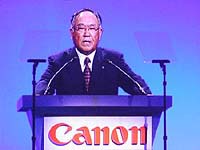 |
Canon President and CEO
Fujio Mitarai delivered an impressive keynote speech
(Over an hour, in English) |
I'm writing this on the plane back from New York, having spent the last day and a half attending Canon's Expo2005 at the Javits Center. Canon apparently mounts these extravaganzas every five years, but this was the first one that I'd attended. It was a pretty amazing event, nothing less than a one-company trade show, that filled an entire hall of the huge Javits Center.
I guess you'd expect that an event of this sort would be crafted to present the company involved in the best possible light. Even allowing for company-generated hyperbole though, it's difficult to argue with the numbers that Canon presented. Prior to this event, I knew that Canon was a very successful digital camera maker, but had no idea of the scope of the company as a whole, nor the depth of their R&D efforts.
While they don't address the underlying reasons, the charts below sketch an impressive bottom line for Canon's operations over the last ten years. (There were plenty of other charts and figures that explain some of the underpinnings of this, but we're really not a financial-reporting outfit: I share the numbers above to help explain some of Canon's strength in the digital camera field.) Bringing manufacturing and operating costs under control through a series of operational and structural tweaks, Canon has not only grown their top line revenue by nearly 70% in the last ten years, but in the process has paid down over seven billion dollars in debt.
 | 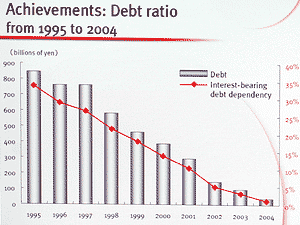 |
In ten years, sales have increased ~70% | At the same time, debt has dropped from
$7.6 billion to $0.3 billion |
This is impressive enough in itself, but the real story lies in what Canon intends to do with the flood of cash, now that their debt has been brought under control. The short answer is more research and product development. - A lot more.
Canon has already been spending huge amounts on R&D, something on the order of $2.4 billion last year. As a result, they filed more than 1800 US patents in 2004 alone, placing them third among all companies worldwide in US patent filings. This translates directly into the strength of their product line, as witness that nearly 65% of their current revenue comes from products that didn't even exist two years ago. It has also helped them become ever more vertically integrated, manufacturing many of the components that go into their own products, further reducing costs and improving product development agility.
An R&D budget of $2.4 billion is a lot by any standard, but Canon intends to increase that to $4.5 billion over the next few years. In addition to pure R&D though, Canon has also been investing heavily in production capacity, having recently built a new semiconductor fab essentially next door to their main production facility for digital cameras. - Image sensors are one of the few key components of their consumer cameras that Canon doesn't manufacture themselves, but the existence of this new fab suggests that it won't be long before they bring that function in-house as well.
All this is by way of background for the discussion that follows, covering some of the digital photo-related technologies that I saw on display at the Expo: It's clear that Canon is going to be pushing the technology envelope in digital photography for some years to come, while simultaneously ratcheting up the price pressure on their competition. Bad news for their competitors, but decidedly good news for consumers.
I won't report on the parts of the Expo that dealt with Canon's technology in other areas (office equipment and medical imaging in particular occupied large parts of the show floor), and there weren't any actual new-product announcements in the digital still camera arena. (If you're a videophile though, you'll definitely want to Google for info on their new H1 high-definition camcorder.) There's still plenty to talk about though, specifically WiFi connectivity for their PowerShot digital cameras, unique face-tracking and smile-detecting software, OLED development, and miniaturized hydrogen fuel cells. - And as a bonus, the "I've got to have one of these" SED flat-screen TV technology. (OK, the last doesn't have a lot to do with photography other than using it to view your photos, but it's just too cool not to mention.)
WiFi: Coming (soon?) to a PowerShot near you.
By now, WiFi on digital cameras, even consumer cameras, isn't exactly news. Nikon is about to start shipping their Coolpix P1 and P2, and Kodak has said that their ambitious EasyShare One will be coming to retail shelves in October. That said though, Canon's WiFi demo at the Expo was pretty impressive.
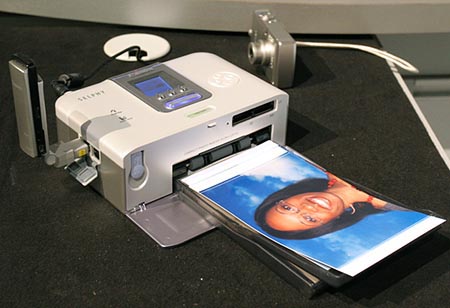 |
A WiFi-equipped SELPHY printer.
(The unlabeled PowerShot digital camera in the background has WiFi built in.) |
There were two components to Canon's WiFi demo, a WiFi-equipped PowerShot digital camera (sans model number, this was apparently entirely a laboratory sample), and a WiFi cartridge that plugged into the PictBridge port of a Canon printer. (Both SELPHY and Pixma printer models were shown working with the WiFi PowerShot.)
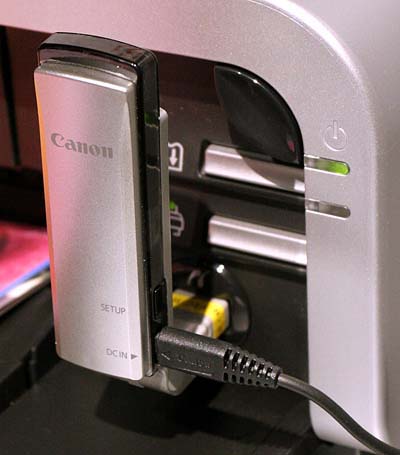 |
A closer look at the WiFi printer plug.
It connects via the printer's PictBridge USB jack. |
The shot above shows a closeup of the WiFi plug connected to the SELPHY. The wire connection is for power to the WiFi module. A button above the power jack is labeled "Setup," but no details were given on how one would go about configuring the modules and setting up the connection. The prototype WiFi PowerShot did have the capability to connect to either of two printers in the booth though, as well as to a WiFi-equipped laptop computer.
One significant difference between the Canon WiFi approach and that which Nikon has recently deployed in their Coolpix P1 and P2 models is that the Canon WiFi PowerShots can communicate with non-WiFi-equipped computers, using an "infrastructure" mode. That is, as long as you have a computer operating on the same ethernet segment as a wireless access point, you'll be able to transfer files to that computer, even if it isn't itself WiFi equipped. -- The Nikon cameras can only "talk" to a computer equipped with WiFi capability, even if there's an access point connected to the same network. (Of course, it must be pointed out that the WiFi Coolpix models are due to ship very soon, while no date has yet been given for the WiFi PowerShots. - It's conceivable that Nikon will also support Infrastructure Mode by the time Canon's WiFi products make it to market.)
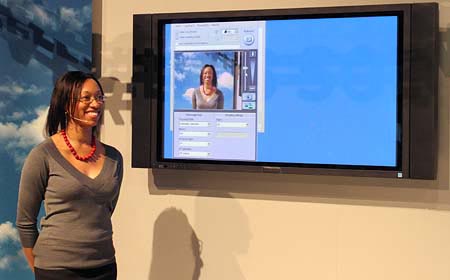 |
Most surprising about the Canon WiFi solution was that it allowed remote control of the camera from a computer, with a live viewfinder display. |
The most surprising thing about the Canon WiFi demo was that the WiFi PowerShot could be controlled remotely from a host computer, including a live video viewfinder. The viewfinder refresh didn't seem quite up to the speed of the rear-panel LCD, but it was quite responsive, definitely very usable.
Another note worth making: While the Canon WiFi system was only operating at 802.11b speeds (rather than the faster 802.11g), file downloads were very zippy: A maximum-quality file from the 5-megapixel prototype WiFi PowerShot took only a couple of seconds to transfer to the host computer or printer. A Canon engineer told me that the files were about a megabyte apiece, so the overall transfer speed wasn't perhaps half that of a fast USB v1.1 connection, but definitely in the "bearable" range for routine use in offloading a camera.
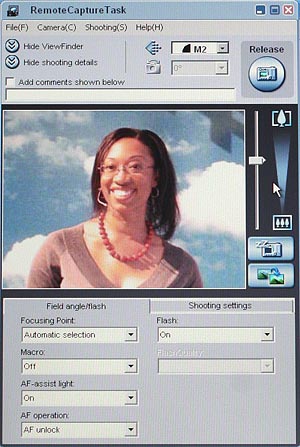 |
Here's a look at the Remote Capture screen, controlling the camera via a WiFi link. |
Here's a closer look at the Remote Capture screen, running the PowerShot remotely. Of note there is that you could control pretty much all the camera functions from the computer, including lens zoom. - And the controls were quite responsive, with very little lag or delay between making an adjustment and seeing the effects in the viewfinder display.
All in all, it was a very smooth demonstration of WiFi capability. There was no word at all though, on when this might make it out into products. The Canon staff were resolute in refusing to offer even a hint of when we might see this in products. They were also fairly cagey about whether the WiFi printer plug would work with non-Canon printers. It does appear that it adheres to the PictBridge standard, but the engineering rep said that they couldn't necessarily guarantee that a third-party printer would properly implement the commands that they were using. (Reasonable enough, I suppose, but it'd sure be nice if the gadget would be backward-compatible with existing PictBridge output devices.)
OLED displays
There's been a lot of talk for some time now, about "Organic Light-Emitting Diodes" or OLEDs. Canon has apparently been working on this technology themselves, and had some samples on display. (Apologies, I completely neglected to snap any photos of the demo itself.)
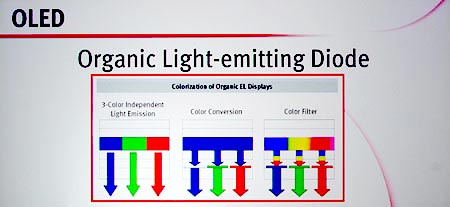 |
OLEDs should bring many advantages for digital cameras, as compared to the LCD technology in use today for rear-panel display screens. |
OLEDs (on the left in the diagram above) differ from conventional LCDs (on the right) in that each pixel emits colored light directly. This has several advantages, a key being that there are virtually no viewing-angle limitations caused by polarizing filters, so the display is readable from almost any angle. Also, since the light isn't being filtered from a white backlight, the overall system is much more efficient, producing a much brighter, more vivid picture with less power drain.
The significance for Canon is that OLED technology would give them their own, in-house display capability, taking care of the other major digital camera component (besides CCD sensors) that they don't currently manufacture themselves.
As with other technology on display (no pun intended), Canon was noncommittal about exactly when we might see cameras with OLEDs on their backs. It does appear though, that this could happen as early as sometime next year.
Face Tracking and Smile Detection
In what looked like one of the more "over the horizon" technology demos, Canon was showing face identification and tracking software, and even blink and smile detection capabilities. (Face detection isn't entirely new, as both Nikon and Konica Minolta have incorporated some form of it into their cameras in the past. What was new here was how quickly the Canon demo system could track a moving face, and the ability to detect smiles and blinks.) This was all running on host computers, but it was pretty impressive nonetheless. The face detection software in particular looked pretty robust, able to pick out multiple faces in fairly cluttered scenes. Building off of this basic capability was a face-tracking system that was amazingly agile, able to track your face, no matter how vigorously you bobbed, weaved, or even jumped.
The most entertaining example of "face" technology though, was the Smile Detector, shown below.
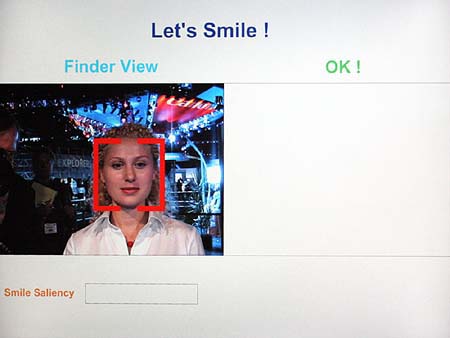 |
Canon's conceptual demo of "Smile Detection." The demo started with the computer finding a face near the center of the frame. If the person had a neutral or frowning expression, no action was taken. |
The Smile Detector demo began with you standing on a line on the floor, with your face in a neutral expression. The software would detect your face, put a yellow frame around it to show that it had found you, and a moment later, the frame would turn red, indicating that you weren't smiling.
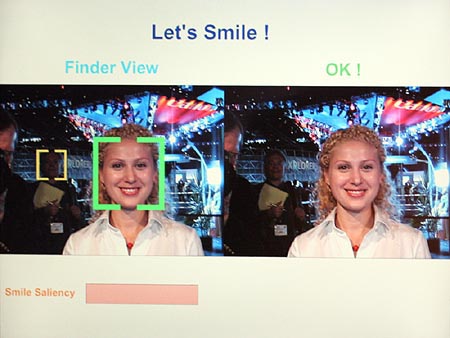 |
As soon as the subject smiled though, the frame around the face turned green, and the computer snapped a picture. |
As soon as you smiled though, the frame would turn green, and the computer would snap your photo. (Complete with the typical PowerShot shutter click sound.) A bar display showed how "Salient" the computer thought your smile was. (In the shot above left, you can also see that the computer has detected another face in the background, despite being in fairly deep shadow.)
I say that this all seemed rather "over the horizon" to me, because I strongly suspected that it was being powered by a very beefy personal computer under the table. It could be a while before the necessary level of processing is available in a digital camera. -- But then, who knows?
Fuel Cells: Big power in tiny packages
Here's another "holy grail" item for digital camera (and other high power drain portable electronics) makers: A miniaturized fuel cell, to replace rechargeable batteries.
This is another area where a lot of companies have been working for quite a while now to come up with a practical product. So far (to the best of my knowledge), nobody has succeeded in making a device that's compact enough, safe enough, and cheap enough for deployment in consumer devices.
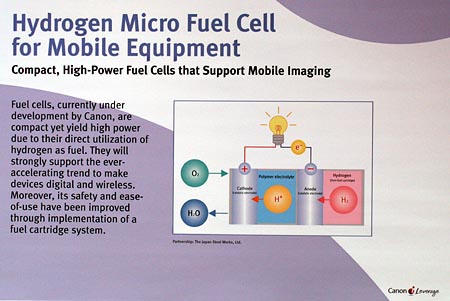 |
Fuel cell technology promises to deliver high power in very compact packages, great for digital cameras and camcorders. |
Whatever their actual fuel source (larger commercial fuel cells typically run from hydrocarbon fuels like natural gas), the ultimate operation of a fuel cell comes down to combining hydrogen and oxygen atoms across a special membrane. Electrochemical sleight of hand converts the energy thus released directly into electricity, at very high efficiency.
The potential benefit of fuel cell technology for portable electronics is that typical chemical fuels store energy much more densely than any battery system yet conceived. Thus, a much smaller device could power a camera or other portable device for much longer than a battery could. With fuel cells, there's also the potential to "gas up" your device simply by adding more fuel, rather than enduring a long battery charging cycle.
Most fuel cell technology currently in use requires complex chemical gyrations to strip the hydrogen atoms off the fuel molecules, adding complexity, cost, and unwanted byproducts. (Typically CO2 or CO.) Canon's approach is to skip the middleman, so to speak, and work directly with hydrogen in the first place.
Of course, hydrogen is tricky stuff to deal with, having very poor energy density in its gaseous form, unless you compress the heck of it. (And I don't think most consumers would be crazy about carrying around a 4000 psi hydrogen cartridge in their pockets.)
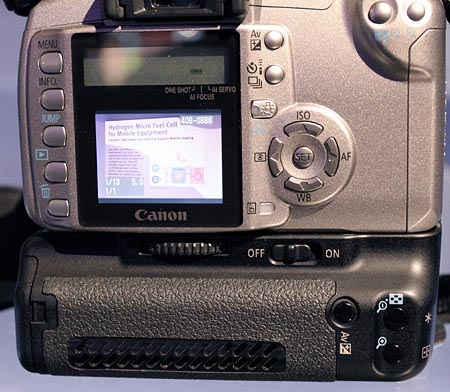 |
In this shot, a hydrogen fuel cell has been built into a standard battery grip, and is powering a Digital Rebel d-SLR. |
Canon's approach is to use metal hydrides to store the hydrogen. Metal hydrides are metal-hydrogen compounds that can pack an astonishing amount of hydrogen gas into a very small space, without requiring high pressures or extreme temperatures. Naturally, there's more to it than just saying "let's use metal hydrides," but Canon seems to be getting a pretty good handle on it: The shot above shows a hydrogen fuel cell built into the battery grip of a Canon Digital Rebel -- and powering the camera. The slots along the bottom edge of the grip let the cell "breathe," drawing in the oxygen it needs to generate power.
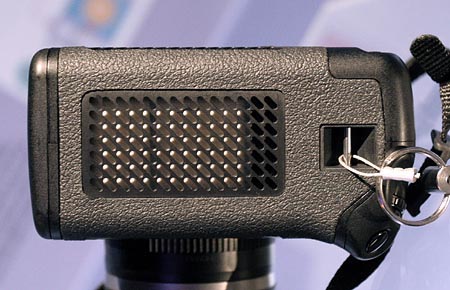 |
Here's the "exhaust pipe." The fuel cell combines hydrogen from its fuel pack with oxygen from the air, producing electricity and water vapor. The water vapor exits through this grille in the bottom of the battery pack. |
The bottom of the modified battery grip sports a large grille that serves as the fuel cell's "exhaust pipe." In this case, the "exhaust" is simply moist air, the water produced by the fuel cell's reaction exiting as vapor. (It's not clear how this might work in a more conventional camera design, since digital camera designs don't generally have a lot of room for a large ventilation grille of this sort. - And it's also not clear how susceptible a fuel cell equipped camera would be to dust, dirt, or liquid water.) Another potential issue could be the cost of the metal hydride "fuel packs." To be commercially practical, they'll need to deliver a cost per watt-hour at least similar to conventional primary batteries.
The biggest benefit claimed for fuel cells has been energy density, the amount of power that can be packed into a given volume. When questioned, the Canon engineers reported that the prototype fuel cells have an energy density of 0.6 cubic centimeters per watt-hour. That would be ten watt-hours in a volume only 2 x 3 x 1 cm. For comparison, the best rechargeable AA cells pack about 10-11 watt-hours per set of four cells, so the Canon fuel cell technology does indeed appear to pack a lot more punch for a given volume.
Don't expect to see a fuel cell coming to a camera near you any time soon though: While they did have a working demo, the Canon engineers were quick to point out that the technology was still really only at the laboratory stage.
The "I want it" department: SED flat-screen displays
OK, this has nothing (or at least relatively little) to do with digital photography, but it's just so darn cool that I can't help talking about it.
Flat-panel televisions are getting to be pretty common these days, although prices are still rather high. Current flat-panel technologies are also less than ideal, for a variety of reasons. Plasma panels are big, heavy, delicate, and gobble prodigious amounts of power. LCDs are lighter, but tend to have limited viewing angles, have difficulty producing very dark blacks, and can be a little sluggish when it comes to showing fast action.
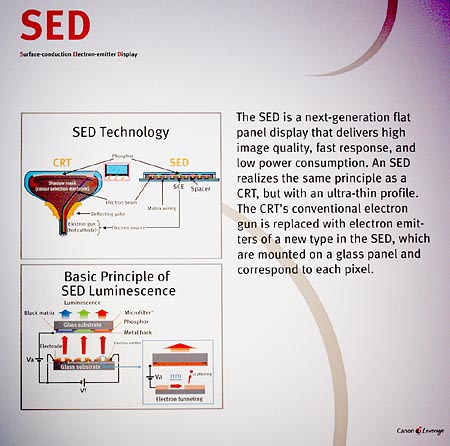 |
Here's a graphic showing the basic concept of the SED display technology. A side by side comparison with Plasma and LCD panels was quite impressive, but the setup wasn't conducive to photography, as there wasn't room to fit all three screens into a single exposure. Beautiful images though, I really want one of these on my wall! (Click on the image to see a larger version) |
Enter Canon with an entirely new technology, called SED, short for Surface-conductive, Electron-emitter Display. As the diagram above shows (click to see a larger version), the SED can be thought of as having a microscopic CRT behind each red, green, or blue pixel.
The bottom line for the SED is a host of improvements, across the board. Brightness is excellent, blacks are absolutely black, response times are as low as one millisecond (that's fast), and the viewing angle is essentially 180 degrees. Not least, the power consumption of the SED is lower than either other technology, dramatically so when compared to plasma screens.
Canon had a demo set up, showing a plasma panel, an SED, and an LCD screen side by side. The comparison was pretty dramatic. While Canon could have deliberately chosen less than excellent examples of the other technologies, I don't think they did. (Or, at least not in the case of the plasma panel; I do think that I've seen better-looking LCD screens.) In any event, the things that stood out about the other technologies were exactly what you'd expect. Especially in the case of the LCD, the black levels that were more gray than black and the limited viewing angle were both very evident, and very characteristic of the technology in general.
Bottom line, the SEDs shown at the Expo just looked beautiful. - Count on me being one of the first in line whenever these start showing up in stores. (Again, of course, no date on when these will hit store shelves. The impression I got was that it could be a while. It does appear though, that Canon has already begun the process of ramping up production on a pilot basis.)
Conclusion
As I said at the outset, it would have been a surprise if the Canon Expo didn't portray Canon in a pretty favorable light. Even taken with the necessary grain of salt though, the result was pretty impressive. - And facts are facts, there's no arguing with the financial numbers Mr. Mitarai set out in his opening message. What I'm looking forward to is seeing all those billions spent on R&D turning up in hot new digital imaging products that we can tell you about in the years to come!